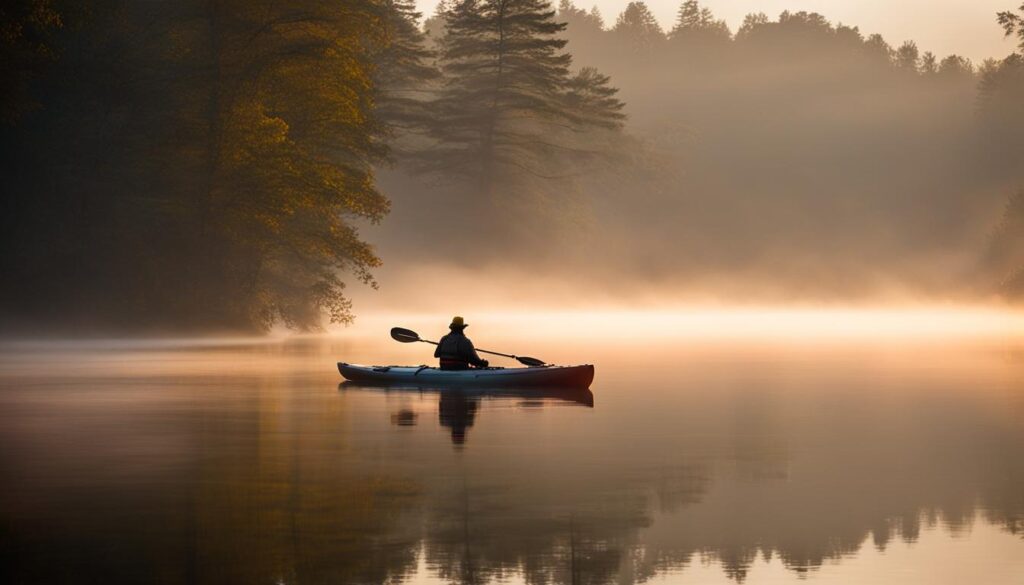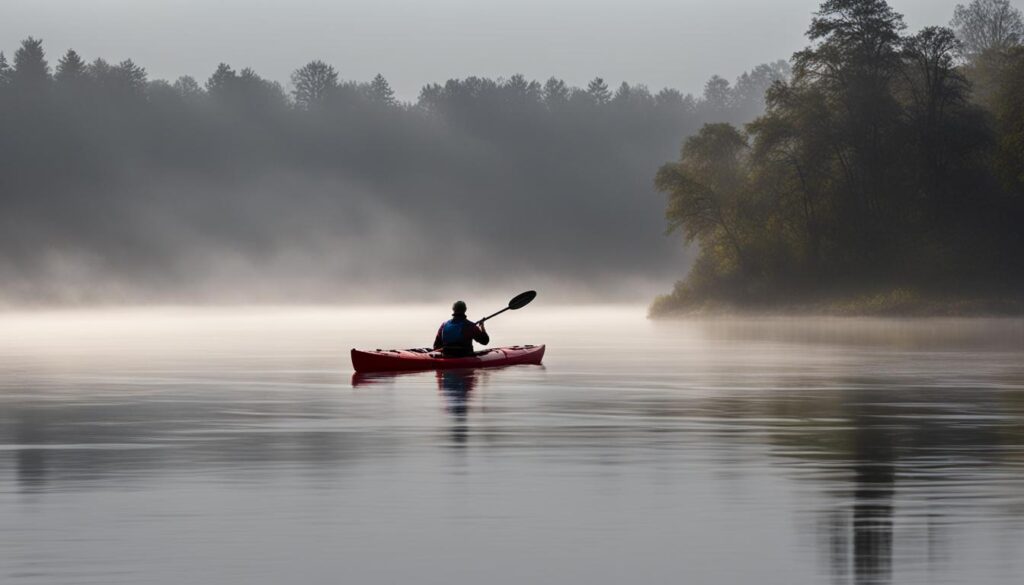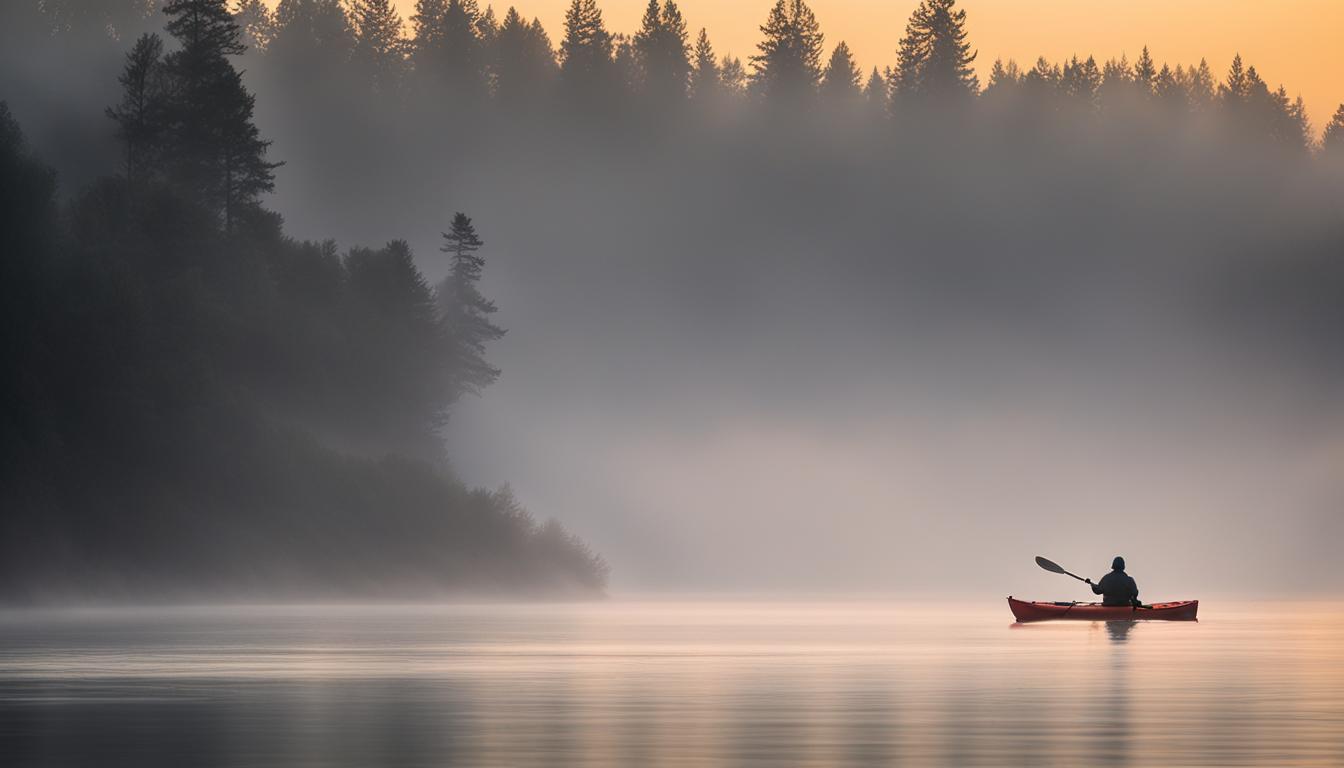Experience the mystical allure of foggy morning kayaking and immerse yourself in the enchanting atmosphere it creates. However, venturing out on the water in reduced visibility requires caution and careful preparation. To ensure a safe and enjoyable journey, it is crucial to take necessary precautions when kayaking in foggy conditions.
Whether you’re a seasoned paddler or a beginner, understanding the safety measures for foggy morning kayaking is essential. By following these precautions, you can navigate through the fog with confidence and maximize your experience:
Key Takeaways:
- Always check the weather forecast before heading out to determine if foggy conditions are expected.
- Equip your kayak with appropriate safety devices, including a fog horn, whistle, and a personal flotation device.
- Use proper lighting, such as a headlamp, kayak navigation lights, and reflective gear, to enhance your visibility.
- Employ navigational aids like a compass or GPS to maintain your course and prevent disorientation in foggy conditions.
- Stay aware of your surroundings, listen for nearby vessels, and maintain a safe distance from other watercraft.
By taking these precautions, you can embrace the allure of foggy morning paddles while ensuring your safety and enhancing your overall kayaking experience.
Navigating Fog in Kayaking: Techniques and Tips
When it comes to kayaking in dense fog, having the right techniques and tips can make all the difference in ensuring a safe and enjoyable experience on the water. Navigating through reduced visibility requires heightened awareness and careful navigation strategies. Here are some key strategies to consider:
Taking Proper Precautions
Before setting out on your foggy kayaking adventure, it’s essential to take the necessary precautions. Start by checking the weather forecast to ensure you’re aware of any potential changes or hazards. Dress appropriately for the conditions, including wearing a life jacket and having a whistle for emergencies. Additionally, equip your kayak with proper lighting, such as a bright headlamp or navigation lights, to increase your visibility to others on the water.
Using Landmarks and Navigation Aids
One of the most effective ways to navigate through fog is by using landmarks and navigation aids. Familiarize yourself with the area beforehand and identify distinct landmarks that can help guide your way. This could be a prominent tree, a specific rock formation, or a buoy. Additionally, make use of navigational tools such as a compass or GPS to maintain your sense of direction. Be cautious of relying solely on technology, as it may not always be reliable in foggy conditions.
Staying in Close Proximity to Others
In foggy conditions, it’s wise to stay in close proximity to other kayakers or boaters. This provides an additional layer of safety by increasing your visibility to others and reducing the risk of getting lost. Additionally, maintaining communication with your fellow paddlers can help alert each other to any potential hazards or changes in direction. Remember to use whistle signals or agreed-upon hand signals to communicate effectively.
By implementing these techniques and tips, you can navigate through dense fog with confidence and minimize the risks associated with reduced visibility. Always prioritize safety and take the necessary precautions to ensure a memorable and safe kayaking experience.
Benefits of Kayaking in Misty Conditions
Kayaking in misty conditions can provide a truly unique and captivating experience for outdoor enthusiasts. While foggy mornings may require extra precautions, they also offer several advantages that make the adventure worthwhile. Let’s explore some of the benefits of kayaking in misty conditions.
Sense of Serenity and Tranquility
As you glide through the mist-covered waters, a sense of serenity and tranquility envelops you. The ethereal atmosphere created by the fog lends a peaceful and calming ambiance to your kayaking experience. The quietness of the surroundings, undisturbed by outside noises, allows you to connect with nature on a deeper level and find solace in the stillness.
Enhanced Visual Appeal
Kayaking in misty conditions adds a layer of visual appeal to your journey. The interplay of light and fog creates a mystical and dreamlike setting, transforming the familiar scenery into something enchanting. The ethereal quality of the mist enhances the beauty of your surroundings, making every paddle stroke a feast for the eyes.
Heightened Sense of Adventure
Kayaking in misty conditions adds an element of mystery and excitement to your adventure. The limited visibility challenges your senses, making each paddle stroke a thrilling exploration. As you navigate through the fog, you never know what lies just beyond your reach, keeping you engaged and on your toes throughout your journey.
So, if you’re up for a unique and memorable kayaking experience, don’t shy away from misty conditions. While it’s important to exercise caution and adhere to safety precautions, the benefits of kayaking in the fog far outweigh the challenges. Embrace the mystical ambiance, revel in the enhanced visual appeal, and let the heightened sense of adventure take you on a remarkable journey.

Kayak Trip Planning for Foggy Conditions
Planning a kayak trip in foggy conditions requires careful preparation and consideration. While the mystical allure of foggy mornings can be enticing, it’s important to prioritize safety by taking certain precautions.
First and foremost, check the weather forecast before embarking on your kayak adventure. Fog can quickly descend and reduce visibility, so it’s essential to plan your trip during a period when fog is expected to be minimal or dissipating. You can find reliable weather updates from local sources or online platforms specifically designed for water sports enthusiasts.
Additionally, equip yourself with the necessary safety gear to navigate in reduced visibility. Make sure your kayak is equipped with appropriate lighting, such as a white stern light and a red or green navigational light. These lights will make you more visible to other watercraft and help you maintain awareness of your surroundings. You should also consider wearing a brightly colored personal flotation device (PFD) to enhance visibility.
Table: Essential Items for Foggy Kayak Trips
| Item | Description |
|---|---|
| Navigation lights | White stern light and red/green navigational light |
| Brightly colored PFD | Enhances visibility in low light conditions |
| Whistle or horn | Signaling device to alert others of your presence |
| Compass or GPS | Aids in navigation and maintaining direction |
| Waterproof map or chart | Provides visual reference for your route |
Furthermore, it’s crucial to stay alert and maintain a slower pace when kayaking in foggy conditions. Reduce your speed to increase reaction time and avoid collisions with other watercraft or obstacles that may be obscured by the fog. Use caution when navigating near shorelines or areas with potential hazards, such as rocks or submerged objects, as they may be harder to detect in reduced visibility.
By following these guidelines and thoroughly planning your kayak trip, you can enjoy the enchanting experience of paddling through misty conditions while prioritizing your safety.

Conclusion
Kayaking in foggy conditions presents unique visibility challenges, requiring extra precautions to ensure safety on the water. Despite the risks, foggy mornings can offer a captivating and extraordinary experience for kayakers. By taking the necessary steps to mitigate hazards and stay alert, you can navigate through reduced visibility with confidence.
Prior to embarking on a foggy kayaking adventure, always check the weather forecast and be prepared for changing conditions. Fog can roll in quickly and reduce visibility significantly, making it crucial to have the right equipment and knowledge to navigate safely.
Using proper lighting, such as a bright headlamp or waterproof flashlight, is essential for increasing your visibility and alerting other boaters to your presence. Additionally, consider using a compass or GPS device to maintain your bearings and avoid getting disoriented in the fog.
Remember to remain vigilant and aware of your surroundings at all times. Keep a safe distance from other watercraft and be cautious of potential obstacles that may be hidden by the fog. By applying these precautions and staying prepared, you can confidently enjoy the enchanting experience of kayaking in reduced visibility.
FAQ
What precautions should I take when kayaking in foggy conditions?
When kayaking in foggy conditions, it is essential to check the weather forecast beforehand, use proper lighting on your kayak, stay close to the shore, and consider using a compass or GPS for navigation.
How can I navigate safely in dense fog while kayaking?
To navigate safely in dense fog while kayaking, you can use techniques such as paddling slowly and quietly, listening for sounds and wildlife, and using a whistle or horn to signal your presence to other boaters.
What are the advantages of kayaking in misty conditions?
Kayaking in misty conditions can provide a unique and magical experience, with a sense of tranquility and a beautiful, ethereal atmosphere. It also offers the opportunity to observe wildlife and nature in a different light.
What should I consider when planning a kayaking trip in foggy conditions?
When planning a kayaking trip in foggy conditions, make sure to inform someone of your plans, bring a waterproof map or navigational aid, wear appropriate clothing and a personal flotation device, and stay aware of any changes in weather or visibility.
What challenges do foggy conditions pose for kayaking?
Foggy conditions present challenges for kayakers due to reduced visibility, making it harder to navigate, spot other watercraft or obstacles, and find your way back to shore. It is important to take extra precautions to ensure your safety in these conditions.





